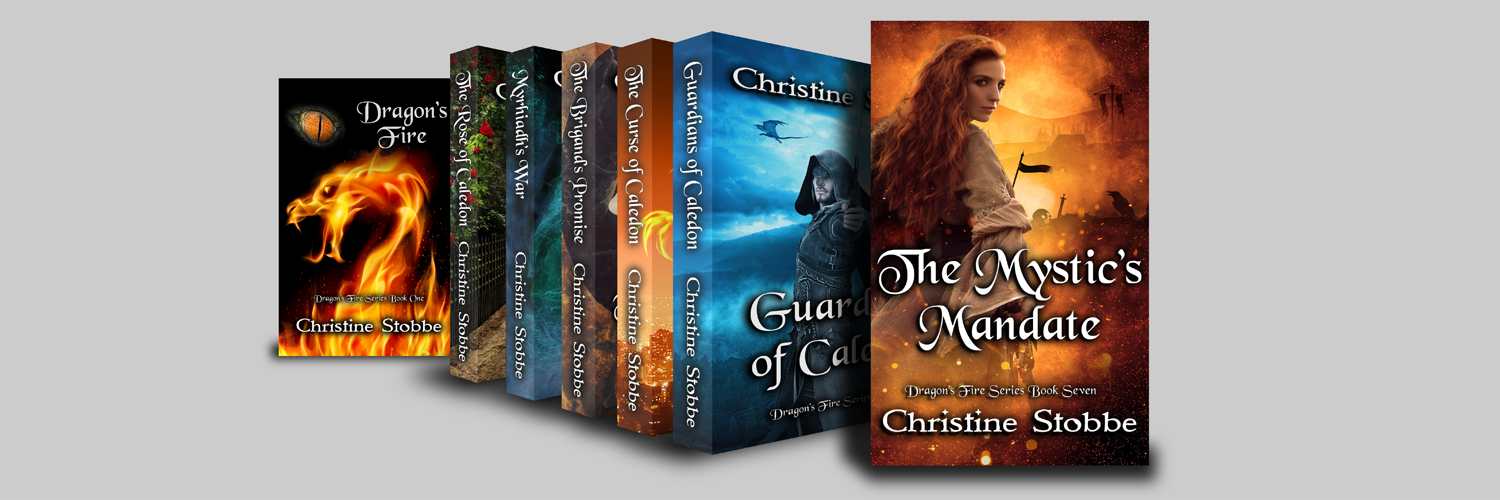|
Self-publishing the Dragon’s Fire Series is a huge undertaking. Independent publishers tackle every aspect of producing a book, unlike in traditional publishing, where a team handles the project. Between myself, my Beta readers, and my husband, I have a team, but it’s a small one.
The first step is writing the story. The idea in my head progresses to a fleshed-out novel in stages. First, I write a plot. Usually. Myrhiadh’s War never had a plot—it just spilled out over 33 days, and I finished it before I realized I had put little planning into it. The Rose of Caledon also didn’t have a written plot, because I’d been thinking about it for seven months before I started typing. The other titles have plots to guide the general direction of the narrative. (Characters invariably take over and change the storyline—Book Nine is currently not even pretending to follow the plot.) The first draft is just me telling myself a story. Grammar and syntax are irrelevant—I want to get the ideas onto the page. Later drafts focus on plot development and character arcs. Some books only require two drafts before they’re ready for editing. Others need more. The Assassin’s Redemption had four drafts; The Mystic’s Mandate had seven. Beta readers help me during the drafting stage, looking for plot holes and character inconsistencies and making suggestions to improve the story. However many drafts I write, the final one is a blend of drafting and editing, where I give the text a quick read-through for continuity and clean-up any glaring errors. Editing begins once I’m satisfied that the story and characters are solid. The first editing pass is huge. Here I focus on style, wordiness, repetition, clichés, grammar, overuse of words and phrases, sentence length, diction, dialogue and tags, sensory development, and passivity. I pore over each paragraph and analyze every word. It can take four or five hours to work through one chapter. The next editing passes are easier, but I keep working on the text until I can read it and find few things I want to change. This can involve any number of passes, but never fewer than four. During the editing stages, Beta readers help by reading for continuity and enjoyment, and pointing out details I’ve missed. Next, the manuscript goes to my editor, who happens to be my husband. He’s a computer guy—very logical, and he does technical writing and editing at work. He never gets lost in the story, and he makes me account for every word I’ve left in the text. Medieval technology in a scene? I’d better be able to satisfy him that what I’ve described would work, or I rewrite until he is. Lapsing into too much retrospection and characterization (he thinks it’s boring)? I’ll have to fix the pacing. Missing information? He’ll catch it. Flaky characters, implausible situations, poor syntax or confusing sentences? If any have survived my scalpel, he’ll find them. Sometimes, he gets a hearty laugh out of my inadvertent mistakes. After that exercise in humility, the manuscript gets a final check for continuity and to ensure that we introduced no new errors. And then we format it. Formatting for publication is a tedious task. My husband excels at it. He sets margins, analyzes pages line-by-line, decides where to insert hyphens to perfect the justified words, and designs my covers to Amazon’s exacting specifications. I could not do this without him. (We buy the cover art and credit the artists in the books—we are not artists.) After one more quick proofread, the manuscript and cover get uploaded to Amazon so you can read the book! By this time, I’m sick of it, but proud of it—and I’m always glad to hear how readers love it! Readers buy it and read it in a few hours and demand the next one. Which is fantastic. If only I could write them as fast as people devour them!
0 Comments
|
Archives
May 2024
EventsCheck out my interview with blogger Fiona Mcvie! https://wp.me/p3uv2y-75n
|
